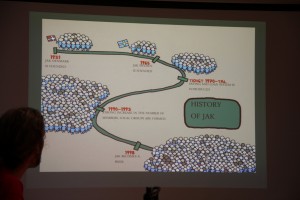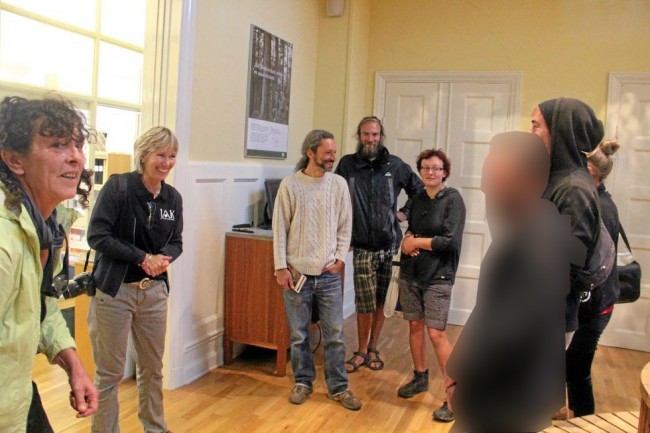On the 22nd of July, Biketour passed by Skövde on the way from Bossgården to Broddetorp. Skövde is a small town of 35 000 inhabitants somewhere in the middle between Vättern and Vänern, the two big lakes of Sweden. It happens to be the place where JAK Medlemsbank, a members-owned alternative bank, was founded in 1965 based on the concept of JAK Denmark, which has existed since 1931. Knowing some alternative banks from other countries, which are a part of the capitalist system just like any other bank, except that they invest their money into more social and sustainable projects, it seemed to us like a bank would not be the kind of thing that the Biketour would want to visit. But JAK bank has been one of the projects most recommended by former Biketour participants from Sweden and by people we met on the way, so we got in contact with them and were invited to visit the headquarters by the director of the bank himself, who was even interested in cycling with us on that day (which was to us quite surprising for a boss of a bank that has branches all over Sweden).
The way that JAK presents itself and what people told us about it, it is basically a group of currently 40 000 people who lend their money to each other, in the way that friends would do, so without an interest rate and without judging on the base of profit and revenue who to lend money to.
Entering the headquarters of the bank was almost like two worlds colliding – 20 smelly unwashed cyclists entering a building that is so clean and tidy that it almost smells like hospital. Down in the basement we first had lunch with the manager and the communicator of the bank (at JAK they always have a pot of vegan food in the cafeteria in the basement, and the soup was amazing!) and then received a one-hour presentation about the concept of the bank.
 It turns out that JAK does in fact have an interest rate, the difference is that it is fixed at 3% and thus not dependent on the fluctuation of the market, and it is not used for the bankers’ profit but for the administration costs of the bank. It also turns out that money is not just lent out without conditions: In order to get a loan of 10 000 crowns, you have to make savings of 10 000 crowns – either before or after getting the loan (this so-called “Saving and Loan System” aims to motivate the members to save their money with JAK), which means that people who have more money will be able to get a higher loan. In case someone is not able to pay back their loan, JAK with take the same measures as any other bank to get the money back. Also, JAK does not actually store their members’ money themselves – instead they put it onto accounts that they have with other banks (although we didn’t ask if those banks are picked by any particular criteria, such as not investing the money into the arms industry).
It turns out that JAK does in fact have an interest rate, the difference is that it is fixed at 3% and thus not dependent on the fluctuation of the market, and it is not used for the bankers’ profit but for the administration costs of the bank. It also turns out that money is not just lent out without conditions: In order to get a loan of 10 000 crowns, you have to make savings of 10 000 crowns – either before or after getting the loan (this so-called “Saving and Loan System” aims to motivate the members to save their money with JAK), which means that people who have more money will be able to get a higher loan. In case someone is not able to pay back their loan, JAK with take the same measures as any other bank to get the money back. Also, JAK does not actually store their members’ money themselves – instead they put it onto accounts that they have with other banks (although we didn’t ask if those banks are picked by any particular criteria, such as not investing the money into the arms industry).
Still, JAK is a cool concept that has enabled many projects that would otherwise not be possible in a capitalist economy. Being able to get a loan for a project that would be judged unprofitable by other banks has been really important for many people we’ve met along the way. Also, borrowing money from a bank that is not based on profit can make it possible to talk about it and come to an exceptional agreement when you’re temporarily short in money. And after all, a bank where not the investors but the customers make the decisions, that doesn’t make rich people super-rich, and that doesn’t speculate with everyone’s money by investing it into multi-national shit corporations, is already a step in the right direction by itself.
If all banks were like JAK, we would for sure live in a better and more just society. But JAK also shows that many of the problems that our capitalist society has simply cannot be solved in an economy based on money and private property.
Read about our visit to JAK in Skövde Nyheter.






